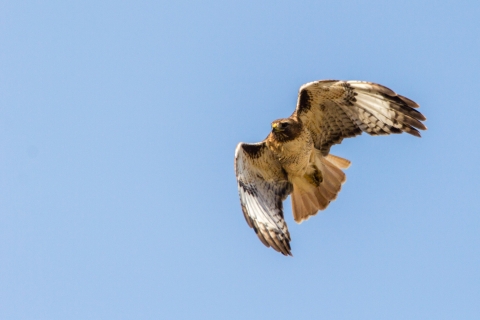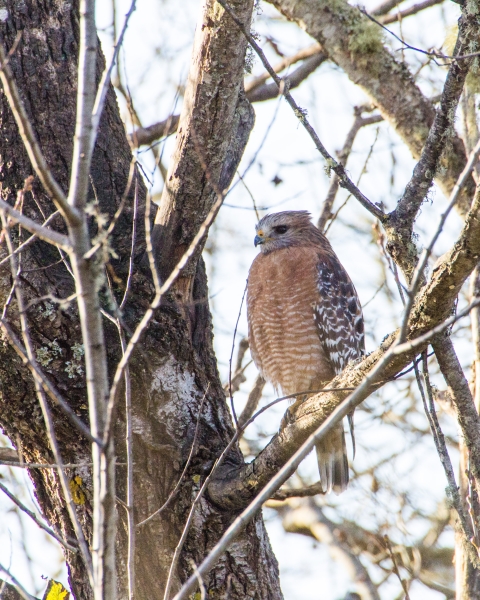Because of their size, speed, and hunting skills, birds of prey (raptors) have earned awe and respect from people of all walks of life. We see this admiration of raptors in names of sports teams, such as the “falcons” and the “seahawks.”
Most birds will exhibit aggressive behavior when they feel threatened. Birds that are guarding a nest are more likely to respond aggressively towards an encroaching person or animal. The most frequent encounters involve birds such as Northern mockingbirds or raptors that make their nests in and around human-populated areas.
Northern mockingbirds and several species of raptors including red-tailed hawks, red-shouldered hawks, Cooper’s Hawks, Swainson’s Hawks, Northern goshawks, broad-winged hawks, and peregrine falcons may display this aggression towards humans during the nesting season, approximately January-August. Goshawks are particularly prone to aggressive air-borne diving on intruders. Some species may be more aggressive than others.
Defensive Behavior
Individual birds defend themselves in different ways. When approached, some birds may call loudly or hiss. The vocalizations are often at a higher pitch and a sharper note, sometimes repeated angrily until the disturbance ends. Another behavior often exhibited by a distressed bird is posturing in which the bird puffs its feathers to make itself look bigger and more threatening. In addition to this, the bird may anxiously weave back and forth. If these threat postures fail to deter a perceived intruder, then the bird may lunge or dive bomb, using its wings, talons, and bill to attack.
What to do if you encounter an aggressive bird
It is best to be patient and understanding whenever you come across a bird that seems to be distressed or aggressive. Recognize the aggressive behaviors and remember that the bird is only trying to defend itself and its young. If the bird is nesting, stay out of the immediate area if possible until the young have fledged (left the nest) and the parents feel less threatened. You should not get too close or attempt to handle wild birds. These birds can be very strong and can potentially do great damage to someone who seems threatening to themselves or their young.
Erect poles with flagging along walkways that are in the vicinity of the nest. When venturing in or around the parent bird’s territory, carry an open umbrella or a stick with flags attached above your head. The raptors will attack the tallest object rather than the person. Never use these objects as weapons to attack the birds. Make sure people are aware of the birds by posting signs in the area. Place portable canopies over frequently-used walkways to provide further protection. In the event that a person or pet is attacked by a bird, and the skin is broken, wash the wound and treat it with antiseptic. Birds do not carry rabies or other diseases communicable in this way.
Recommendations to prevent future attacks
Destroy the nest after the birds and young have all left. During the next breeding season, you may prevent birds from nesting in the area by destroying the nests as they attempt to build one. Be cautious of attacks during this time as well. Hire an arborist to trim the tree before breeding season to discourage them from nesting.
Legal Status
The birds listed above are state and federally protected under the Migratory Bird Treaty Act of 1918. It is illegal for any person to take, possess, transport, sell, or purchase them or their parts, such as feathers, nests, or eggs, without a permit. The regulatory definition of take, as defined by 50 CFR 10.12, means to pursue, hunt, shoot, wound, kill, trap, capture, or collect, or attempt to pursue, hunt, shoot, wound, kill, trap, capture, or collect.
Active nests, meaning nests with eggs or chicks, may not be touched or removed without a permit from the U.S. Fish and Wildlife Service. Removal of empty and inactive nests does not require a permit. Make sure the nest is not in use by watching from a distance with binoculars. If a bird returns to the nest after 15-20 minutes and “sits” on the nest, then the nest is active and should not be disturbed. Nest or bird removal permit applications must be justified with strong, compelling reasons such as a health or safety hazard towards humans and/or birds or damage to property. Check with your state government and the Service for migratory bird permits. The Service does not issue permits for bird nuisance issues.





